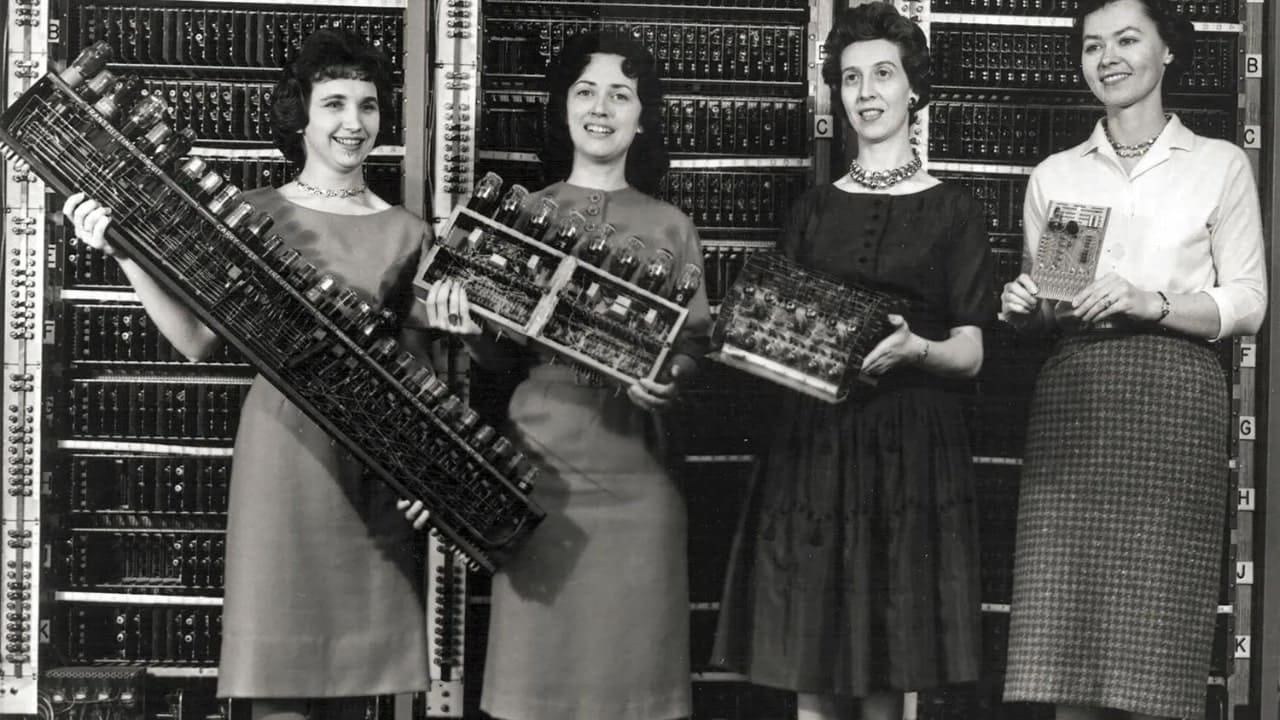
Table of Contents
Women in computer science played a pivotal role during World War II, shaping the technology we rely on today. Did you know that six women are responsible for the smartphone in your hand? Yes, your phone! The one thing you cannot imagine your life without was not built in Silicon Valley’s high-tech labs. Its foundation was laid by visionary women during World War II.
During one of the most devastating periods in history, these 6 brilliant minds were programming the ENIAC, the world’s first electronic digital computer. Operating at the forefront, they were successful in setting a foundation that would define modern computing. Little did anyone know that it would mark a key milestone in the history of computers.
Today, we will take a look at the remarkable yet uncelebrated story of these women in computer science. This is a story about courage, innovation, and breaking the glass ceiling.
The Early Days of Computing
We are all enjoying the fruits of the glorious digital age. But, how many are aware of the history and evolution of computers? Very few know that the seeds of the computer era were sown during World War II. The genesis of the computer can be traced back to the urgent demands of World War II.
Computers were particularly designed for calculating artillery trajectories and managing complex logistical tasks. The early computer which changed the course of the war and technology was a revolutionary response to dire wartime necessities.
The ensuing technological breakthrough was a giant leap forward for humanity and technology in the world. First electronic digital computers marked a monumental shift in how problems were solved, introducing speed and precision previously thought impossible.
ENIAC: The First Electronic Digital Computer

What is ENIAC? The Electronic Numerical Integrator and Computer was the world’s first electronic digital computer. Developed during World War II, it weighed around 30 tons and took up an area of about 1,800 square feet. Want to hear more? 17,468 vacuum tubes, 7,200 crystal diodes, and countless resistors, capacitors, and inductors. Phew!
The job of this massive machine was to solve complex calculations at a speed previously not possible and it marked an important milestone in the evolution of computers.
Who Invented Computers?
Who made computing possible? Legendary figures like Alan Turing laid down the theoretical frameworks, but the practical application of these theories in building the first computers was done by many unsung heroes. More than individual genius, it was a collective push towards the future.
Before the ENIAC, computing was majorly mechanical. There were mechanical and electromechanical machines like the different engines and tabulating machines.
The ENIAC’s leap to fully electronic operations and towards evolution opened a new frontier in the history of computing. It was a never-before-seen technological leap.
The world was going to change!
Women Behind the ENIAC

Meet Jean Bartik, Kathleen Antonelli, Ruth Lichterman, Frances Spence, Marlyn Wescoff, and Betty Snyder. This group of women in computer science were very much part of tech leadership. In 1943, during World War II, these six were recruited by the US Army for a top-secret project.
Let’s get introduced to them:
- Jean Jennings Bartik: One of the original programmers of ENIAC, she was instrumental in developing programmes to perform complex calculations. Rightly so, her contribution laid the foundation for the evolution of computer programming.
- Frances “Betty” Snyder Holberton: She was involved in what can be now understood as an early form of sorting data. Betty’s work was important to the development of the first sort-merge generator, which eventually became a critical component of later computer systems.
- Kathleen McNulty Mauchly Antonelli: This skilled mathematician’s expertise in the subject matter was crucial in solving complex ballistic calculations. Unsurprisingly, she contributed massively to the programming of ENIAC.
- Frances Bilas Spence: Her brilliant work exemplified the practical applications of early computer technology. She was involved in a critical task for the war effort, programming trajectory calculations for artillery.
- Ruth Lichterman Teitelbaum: This key figure in the programming of the electronic digital computer helped to translate various mathematical problems into machine instructions.
- Marlyn Wescoff Meltzer: She ensured that the early computer produced accurate results. How, you ask? She contributed to both the debugging and verification of ENIAC programs.
The ENIAC Women: Pioneers in Computer Programming
Their mission? Program the ENIAC, the Electronic Numerical Integrator and Computer, to calculate artillery trajectories. In other words, the trailblazers programmed the ENIAC to solve complex, critical wartime calculations.
Imagine trying to solve the world’s toughest Sudoku, but what you’re doing is saving lives and steering the course of war. That was their daily grind and they changed the technology in the world.
More than working in technology—they were crafting the programming framework for the future of computing. These programmers tackled unprecedented challenges, from creating programming languages from scratch to debugging without any support. With no manual, person, or reference to guide, they worked tirelessly.
We knew we were supposed to run the machine and set up problems for the machine, but no one had any techniques or anything.
Jean Bartik
In hindsight, the Super Six paved the way for countless women who years later would embrace STEM and continue fighting the stereotypes.
The Impact of Their Work
The expertise of the geniuses paved the way for UNIVAC, the first commercially-produced computer, and yes, the ancestor of your smartphone and all other digital devices in the world.
The programming techniques developed for ENIAC laid the groundwork for subsequent digital computers. At this point in computer history and evolution, the transition from military to commercial computing had begun.
UNIVAC revolutionized business processing. A direct descendant of the ENIAC, it became the first commercially available computer, illustrating how military innovation can propel civilian advancements.
The programming principles developed by these women, hired as human computers transformed into the building blocks for the software industry as we know it. Just think of the scale and magnitude of the industry today. How many of us owe our jobs and even careers to their hard work?
The Forgotten and Unsung Heroes
It wouldn’t be too far-fetched to state that for many years, the women who made computing possible were almost lost to history! But, what about their contributions? Largely, unrecognized!
The focus remained on the first electronic digital computer and technological achievements. The pioneering work of the women programmers in the field of computer science was lost in the depths of the historical narrative. This harsh reality highlights the gender bias which stems from the lack of recognition. Consequently, when we talk about the evolution of computers, the achievements of these women are often overlooked.
Honouring Their Legacy
But, times are changing!
People are making efforts to honour the legacy of these women by shedding light on their achievements and ensuring that the world is made aware of their contributions and remembers the part they played in computer history and evolution.
If you want to know more about them, check out detailed accounts in “Recoding Gender: Women’s Changing Participation in Computing” by Janet Abbate and “Proving Ground: The Untold Story of the Six Women Who Programmed the World’s First Modern Computer” by Kathy Kleiman, cofounder of ICANN (the Internet Corporation for Assigned Names and Numbers). These books are a step in the direction of paying homage to their groundbreaking work.
If you are less of a reader, we have documentary recommendations for you. “Top Secret Rosies: The Female Computers of WWII” showcases the contributions of women who programmed ENIAC.
Let’s honour the legacy of the ENIAC programmers. They didn’t just program a machine; they programmed the future.
Conclusion
Repeat after me: Jean Bartik, Kathleen Antonelli, Ruth Lichterman, Frances Spence, Marlyn Wescoff, and Betty Snyder. Tech leaders in their own right, made computing possible.
Their work opened new frontiers and laid a solid foundation for computer science. Today, technology is an indispensable part of our lives. The impact of these pioneering women’s work extends beyond their wartime contributions. It is evident in every digital device we use today. So, next time you use your phones or tablets, you’ve got these women to thank.
They paved the path for modern digital technology, influencing everything from the way we calculate to how we communicate. We must remember and celebrate the extraordinary women in computer science who made the digital age possible and left their indelible mark on technology and the world.
To keep getting clarity on such interesting topics, please subscribe to Clarity Circuit.
Recommended Articles
If you found this topic interesting, you might also enjoy reading these articles:
- Hanooman AI: Unlocking the Future of AI in India’s Languages
- How Longevity Tech Could Extend Your Life Significantly
- Powerful Impact of Social Media on Political Campaigns in India


